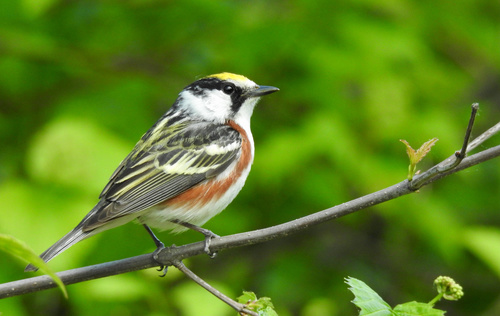
Chestnut-sided Warbler
The Chestnut-sided Warbler (Setophaga pensylvanica) is a small New World warbler known for its distinctive chestnut flanks during the breeding season. This migratory songbird plays a vital role in controlling insect populations within its forested habitats. It is a relatively common species, often associated with early successional forests and shrublands, and is not currently considered to be globally threatened. While not holding any specific, widely recognized cultural significance, it is appreciated by birdwatchers for its vibrant plumage and active behavior.
11-13 cm
Length
16-20 cm
Wingspan
Least Concern
Conservation Status
Distribution
Breeds across eastern North America, from southern Canada (Saskatchewan to Nova Scotia) south to the northeastern United States (Minnesota to New Jersey, and south in the Appalachian Mountains to northern Georgia). Migrates to Central America for the winter, ranging from southern Mexico to Panama.
Lifespan
Up to 9 years recorded, but average lifespan in the wild is likely shorter (2-4 years).
Chestnut-sided Warbler's Habitat
Habitat Types
Deciduous forests, Mixed forests, Shrublands, Young forests, Forest edges
Climate Zones
Temperate, Boreal
Adaptations
Their preference for early successional habitats indicates an adaptation to disturbed environments, allowing them to quickly colonize areas recovering from logging, fires, or other disturbances.
Variations
No recognized subspecies.
Appearance
Breeding Plumage
Breeding males have bright chestnut flanks, a yellow crown, black face mask, and white underparts. Breeding females are similar but duller. Non-breeding birds are much duller, lacking the strong chestnut flanks and black face mask, and have a greenish-yellow back and head.
Seasonal Feather Changes
Significant. Breeding plumage is acquired in the spring, while non-breeding plumage is present in the fall and winter.
Sex Based Plumage Differences
Yes, males are more brightly colored during the breeding season.
Notable Features
Chestnut flanks (breeding males), Yellow crown (breeding birds), Thin, pointed bill
Diet and Feeding
Primary Foods
Insects, Spiders, Caterpillars, Beetles, Ants
Foraging Behavior
Actively gleans insects from leaves and twigs, often foraging in the mid- to upper levels of trees and shrubs. May also hover briefly to catch insects.
Specializations
Their thin, pointed bill is well-suited for picking small insects from foliage.
Seasonal Diet Variations
Primarily insectivorous during the breeding season. May consume some fruits and berries during migration and in the wintering grounds.
Behavior
Social Structure
Generally solitary or in pairs during the breeding season. May form mixed-species flocks during migration and on the wintering grounds.
Communication
Song: a clear, whistled 'pleased, pleased, pleased to meet-cha', Call: a sharp 'chip' note
Migration
Nocturnal migrant. Travels long distances between breeding and wintering grounds.
Territorial or Group Behaviors
Males are territorial during the breeding season, defending their territory through song and chasing intruders.
Conservation
Threats
Habitat loss (both breeding and wintering grounds), Collisions with buildings and other structures during migration, Pesticide use (indirectly through reduced insect prey)
Protection Programs
None specific to this species, but benefits from general habitat conservation efforts.
Local National Laws
Protected under the Migratory Bird Treaty Act in the United States.
Population Trend
Stable
Population Estimates
Estimated global population of 20,000,000 individuals.
Interesting Facts
They often nest in areas that have been recently disturbed.
This makes them a good indicator species for forest regeneration.
The Chestnut-sided Warbler's song is often described as sounding like it's saying, "Pleased, pleased, pleased to meet-cha."
This distinctive song helps with identification.
The Chestnut-sided Warbler undergoes a complete molt twice a year.
A complete molt is when a bird replaces all of its feathers.
Faqs about Chestnut-sided Warbler
Where can I see a Chestnut-sided Warbler?
Look for them in young deciduous forests and shrubby areas during the breeding season in eastern North America. They can also be seen during migration in a variety of habitats.
What do Chestnut-sided Warblers eat?
They primarily eat insects, especially caterpillars, during the breeding season. They may also eat some fruits and berries during migration.
Are Chestnut-sided Warblers endangered?
No, they are classified as Least Concern by the IUCN.
Copyright @ Nature Style Limited. All Rights Reserved.
 English
English